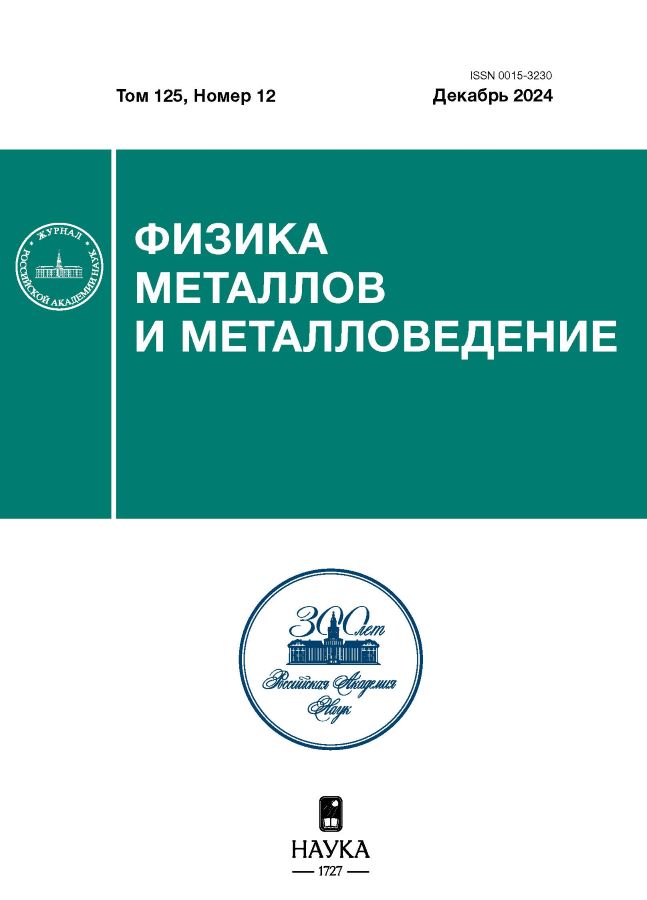Numerical simulation of the structure formation and crystallization of foamed aluminum modified by nanosized particles
- Authors: Popov V.N.1, Cherepanov A.N.1
-
Affiliations:
- Khristianovich Institute of Theoretical and Applied Mechanics, Siberian Branch of the Russian Academy of Sciences
- Issue: Vol 125, No 12 (2024)
- Pages: 1627-1635
- Section: СТРУКТУРА, ФАЗОВЫЕ ПРЕВРАЩЕНИЯ И ДИФФУЗИЯ
- URL: https://innoscience.ru/0015-3230/article/view/681058
- DOI: https://doi.org/10.31857/S0015323024120157
- EDN: https://elibrary.ru/IHWKIK
- ID: 681058
Cite item
Abstract
A mathematical model of crystallization of a foamed aluminum melt (Al–Si) containing modifying nanoscale particles, which is cooled under given heat removal conditions, is proposed. A numerical analysis of the formation dynamics of foamed metal has been performed, and the spherical pore sizes have been determined using a model of gas bubble growth in an aluminum melt. The boundaries of the cells surrounding the bubbles are defined in accordance to the experimental data available in the literature. The developed model demonstrates that the incorporation of nanosized refractory particles into the melt as modifying additives results in the crystal structure refinement and can contribute to the enhancement of the mechanical properties of the solidified metal.
Full Text
About the authors
V. N. Popov
Khristianovich Institute of Theoretical and Applied Mechanics, Siberian Branch of the Russian Academy of Sciences
Author for correspondence.
Email: popov@itam.nsc.ru
Russian Federation, Novosibirsk
A. N. Cherepanov
Khristianovich Institute of Theoretical and Applied Mechanics, Siberian Branch of the Russian Academy of Sciences
Email: popov@itam.nsc.ru
Russian Federation, Novosibirsk
References
- Banhart J. Manufacturing Routes for Metallic Foams // JOM. 2000. V. 52 (12). P. 22–27.
- Banhart J. Manufacture, characterization and application of cellular metals and metal foams // Progress in Mater. Sci. 2001. No. 46. P. 559–632.
- Sandim H., Morante Bruno Vieira, Suzuki P. Kinetics of Thermal Decomposition of Titanium Hydride Powder Using in situ High-temperature X-ray Diffraction (HTXRD) // Mater. Research. 2005. V. 8. No. 3. P. 293–297.
- Bhosle V., Baburaj E.G., Miranova M., Salama K. Dehydrogenation of TiH2 // Mater. Eng. 2003. A356. P. 190–199.
- Cherepanov A.N., Ovcharenko V.T. Effect of Nanostructured Composite Powders on the Structure and Strength Properties of the High Temperature Inconel 718 Alloy // Phys. Met. Metal. 2015. V. 116. No. 12. P. 1279–1284.
- Kuzmanov P.M., Popov S.I., Yovkov L.V., Dimitrova R.N., Cherepanov A.N., Manolov V.K. Investigation the effect of modification with nanopowders on crystallization process and microstructure of some alloys // AIP Conference Proceedings. 2017. V. 1893. P. 030104.
- Сherepanov A.N., Manolov V.K. Application of Nanopowders in Casting Production // J. Mater. Sci. Eng. 2022. V. 11 (02). P. 1–9.
- Turnbul D. Theory of catalysis of nucleation by surface patches // Acta Metal. 1953. V. 1. Iss. 1. P. 8–14.
- Fletcher N.H. Size Effect in Heterogeneous Nucleation // J. Chem. Phys. 1958. V. 29. Iss. 3. P. 572–576.
- Chalmers B. Principles of Solidification. New York: Wiley, 1964. 288 p.
- Flemings M.C. Solidification Processing. New York: McGraw-Hill, 1974. 424 p.
- Borodianskiy K., Kossenko A., Zinigrad M. Improvement of the Mechanical Properties of Al-Si Alloys by TiC Nanoparticles // Metal. Mater. Trans. A. 2013. V. 44. P. 4948–4953.
- El-Mahallawi I.S., Shash A.Y., Amer A.E. Nanoreinforced Cast Al-Si Alloys with Al2O3, TiO2 and ZrO2 // Nanoparticles Metals. 2015. V. 5. No 2. P. 802–821.
- Lazarova R., Bojanova N., Dimitrova R., Manolov V., Panov I. Influence of Nanoparticles Introducing in the Melt of Aluminum Alloys on Castings Microstructure and Properties // Intern. J. Metal. 2016. V. 10. Iss. 4. P. 466–476.
- Popov V.N., Cherepanov A.N. Modeling of the alloy solidification modified by refractory nano-size particles // Eur. Phys. J. Spec. Top. 2020. V. 229(2–3). P. 467–474.
- Попов В.Н. Численное исследование процессов зародышеобразования и кристаллизации в модифицированном расплаве // ФММ. 2022. Т. 123. № 5. С. 469–477.
- Sahu S.N., Gokhale A.A., Mehra A. Modeling nucleation and growth of bubbles during foaming of molten aluminum with high initial gas supersaturation // J. Mater. Processing Techn. 2014. V. 214. Iss. 1. P. 1–12.
- Shafi M.A., Lee J.G., Flumerfelt R.W. Prediction of Cellular Structure in Free Expansion Polymer Foam Processing // Polymer Eng. Sci. 1996. V. 36. No. 14. P. 1950–1959.
- Shafi M.A., Flumerfelt R.W. Initial bubble growth in polymer foam processes // Chem. Eng. Sci. 1997. V. 52. Iss. 4. P. 627–633.
- Mao D., Edwards J.R., Harvey A. Prediction of foam growth and its nucleation in free and limited expansion. // Chemical Engineering Science. 2006. V. 61. Iss. 6. P. 1836–1845.
- Turnbull D. Formation of Crystal Nuclei in Liquid Metals // J. App. Phys. 1950. V. 21. P. 1022–1028.
- Hienola A.I., Winkler P.M., Wagne P.E., Vehkamäki H., Lauri A., Napari I., Kulmala M. Estimation of line tension and contact angle from heterogeneous nucleation experimental data // J. Chem. Phys. 2007. V. 126. P. 094705(1–11).
- Колмогоров A.H. К статистической теории кристаллизации металлов // Изв. АН СССР. Сер. матем. 1937. T. 1. № 3. C. 355–359.
- Christian J.W. The Theory of Transformations in Metals and Alloys. Publisher: Pergamon, 2002. 1200 p.
- Sloane N.J.A. The Packing of Spheres // Scientific American. 1984. V. 250. No. 1. P. 116–125.
- Белецкий В.М., Кривов Г.А. Алюминиевые сплавы. (Состав, свойства, технология, применение). Киев: КОМИНТЕХ, 2005. 365 с.
- Зиновьев В.Е. Теплофизические свойства металлов при высоких температурах. М.: Металлургия, 1989. 384 с
- Варгафтик Н.Б. Справочник по теплофизическим свойствам газов и жидкостей. М.: Наука, 1972. 720 c.
- Hall E.O. The Deformation and Ageing of Mild Steel: III Discussion of Results // Proc. Phys. Soc. B. 1951. V. 64. P. 747–753.
- Petch N.J. The Cleavage Strength of Polycrystals // J. Iron and Steel Institute. 1953. V. 174. P. 25–28.
- Васильева А.Б. О развитии теории обыкновенных дифференциальных уравнений с малым параметром при старших производных за период 1966–1967 гг // УМН. 1976. T. 31. Вып. 6. С. 102–122.
Supplementary files

















